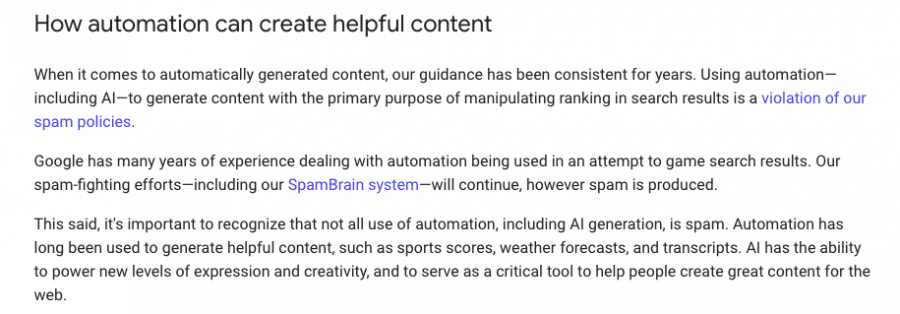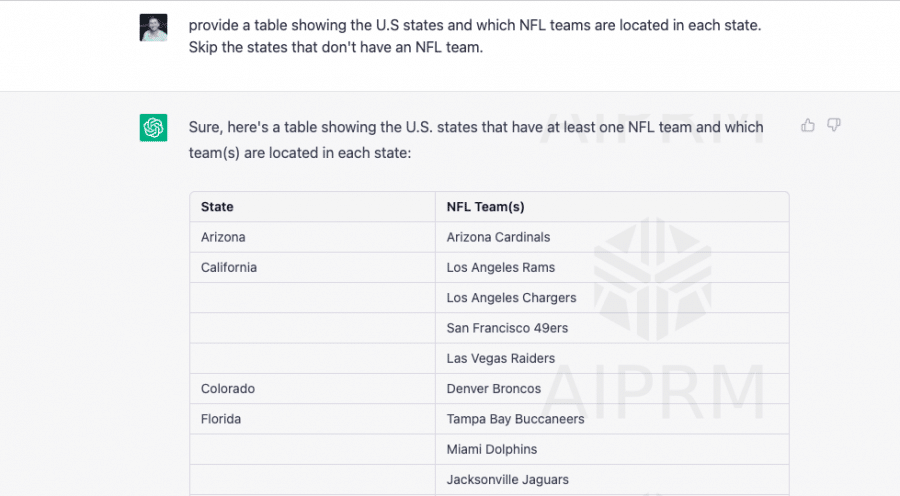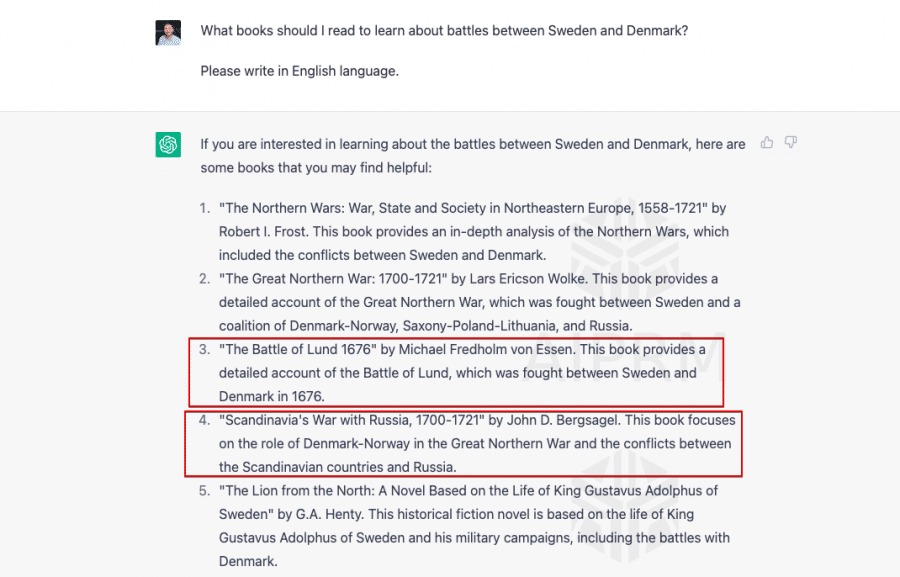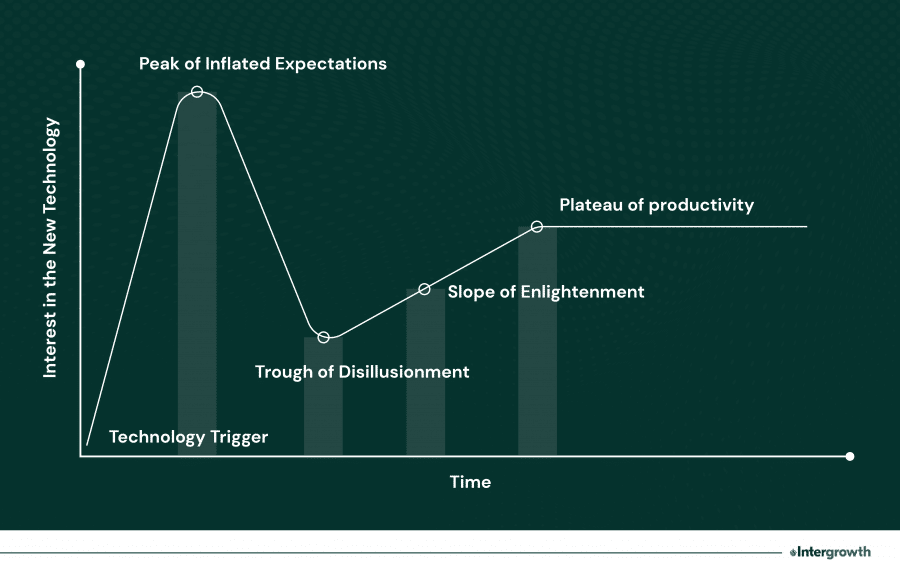Artificial intelligence has dominated my thoughts for the past three months.
I’ve read every article I can find, listened to every podcast episode, spent hours experimenting with ChatGPT, and spoken to dozens of marketers, developers, and entrepreneurs to hear their thoughts.
Today, I want to talk about where AI is today and how it will change the way businesses acquire new customers online.
One caveat: I run an SEO-centric content marketing agency. I’m biased.
Our business drives phenomenal results for clients time and time again. Life would be a lot easier if nothing changed in the marketing industry for the next 10 years. I could watch our business continue to grow and focus on maintaining quality control. That being said, I have no interest in sticking my head in the sand and assuming everything will be alright.
If you disagree with what I share, let me know. I care far more about being right in the long term than in the short term.
As of 2019, 68% of all website traffic comes from search engines. 53% of all website traffic comes from organic search.
Put another way, half of the people who visit your website find you by going to a search engine like Google and clicking on one of the unpaid listings.
One of the most effective tactics for getting more of the right people to your site is SEO-centric content marketing — publishing helpful content on your website to bring more customers to your site from search engines.
Creating content is expensive. The ROI of SEO justifies the cost, largely because the initial investment requirements create a barrier to entry that prevents everyone from creating content.
Today’s AI is capable of spitting out 1,000 words of copy about a given topic in under a minute. So what happens to the channel bringing you half of your customers when the barrier to entry goes to zero?
With that, let’s dive in.
What’s the Status of AI Today?
We’re going to focus on OpenAI, the company behind ChatGPT. Their API is most prominent in other applications that leverage AI technology.
ChatGPT is built on the GPT-3 large language model (LLM). This model uses 175 billion parameters to provide a response to inputted queries.
ChatGPT reached 100 million monthly active users in January 2023, two months after launch. TikTok, by comparison, took nine months to reach 100 million active users.
GPT-4, the next evolution of OpenAI’s LLM, launched in beta on March 14, 2023. Contrary to rumors that it contains 100 trillion parameters (570x more than GPT-3), OpenAI CEO, Sam Altman, debunked that “100 trillion parameters” rumor 5:20 in the following interview with StrictlyVC. However, this updated model will undoubtedly be more powerful than GPT-3.
I’ll update this article if GPT-4 and future models disprove any of the pros and cons highlighted below.
Benefits of Working with AI for Content Marketing
I thought it was only suiting to ask the machine this question first (specifically the benefits of using AI to help with content marketing):
Personalization: AI can analyze data on user behavior and preferences to create personalized content tailored to each individual. This can help improve engagement and conversion rates.
Efficiency: AI can automate repetitive tasks such as data analysis, content creation, and scheduling. This can save businesses time and resources, allowing them to focus on other important areas of their marketing strategy.
Data analysis: AI can process large amounts of data quickly and accurately, providing insights into customer behavior and preferences. This can help businesses make data-driven decisions and optimize their content strategy.
Predictive analytics: AI can use machine learning algorithms to predict future trends and customer behavior. This can help businesses stay ahead of the curve and adjust their content strategy accordingly.
Improved ROI: By automating tasks, personalizing content, and analyzing data more effectively, businesses can improve their ROI and achieve better results from their content marketing efforts.
Overall, AI can provide businesses with valuable insights and tools to improve their content marketing strategy, increase efficiency, and ultimately drive more conversions and revenue.”
Frankly, it’s a pretty decent response that took <2 minutes to create. It’s fluffy, but there are some helpful insights.
My response is that AI is a great tool for generating a lot of mediocre content at low costs.
From our initial tests, we can spit out the first draft of a mediocre article in an hour or two with AI writing tools. Assuming it takes 5-10 hours to write the first draft of a 2,000-word without AI, you could write 5x more articles per hour.
We’ve also found AI to be helpful for generating blog topic ideas, generating code snippets, building tables of specific information sources, and more.
For example, here’s a table ChatGPT put together in <1 minute of NFL teams in each U.S state:
But that leads us to the downsides.
Downsides of AI Technology
There are three main downsides to AI today:
- Article quality
- Legal concerns
- Hallucinations (i.e. misinformation)
Article quality
Today’s AI content creation tools do a decent job of writing articles. However, there are quality limitations to AI-generated content.
AI content generation tools are far from being able to take a two-sentence topic overview and spit out a full-length article with any form of flow. Today’s tools need significant coaching to generate a full-length article.
These tools do a decent job of slinging together statements about a topic. When presented with ideas, they can spit out a paragraph or two of about the idea. From there, the tools need more guidance on what to discuss next.
During its analysis, this technology scans through its database to pull together information on the subject.
If you’re looking to replicate what others have already said, it’s a great option. However, these tools lack the ability to come up with new ideas outside of these datasets.
Put another way, if you’re looking to replicate everything your competitor wrote about in different words, these tools are a suitable option. The articles will lack flow and won’t convey your brand voice. However, they’ll be much more affordable than hiring a professional writer.
This brings us to the second concern: legal.
Legal concerns with AI technology
The main issue that comes with the lack of originality is the threat of plagiarism.
Take these examples found on the CNET and Bankrate website from AI-generated content. Both sites are being accused of plagiarizing competitor sites after they published similar content with minor tweaks. Red Ventures, the company that owns both sites, paused the use of AI content generating tools shortly after these plagiarism accusations came out.
Outside of potential lawsuits, both sites face serious reputational risks.
The second legal concern involves data processing and consumer privacy.
GPT-3 has been trained on 570 GB of data consisting of 300 billion words of copy. Much of this includes social media posts and information shared on personal websites.
As Avast points out, we were never asked whether we consent to this data collection and there currently isn’t a way to request that OpenAI erase our personal data.
So does this comply with GDPR, CCPA, and other data privacy laws? It doesn’t seem like it.
What happens to businesses that use this data via ChatGPT? Will those businesses be liable?
I suspect we’ll see new legislation speaking to this in the coming years. However, I’d encourage proceeding with caution until we know more.
AI hallucinations (i.e. misinformation)
The most alarming part of AI is the frequency of “hallucinations” — statements presented by AI as facts that aren’t true.
Google has faced criticism for misinformation in their Featured Snippets (how many legs do horses have is my favorite example). This problem isn’t unique to OpenAI.
What I see as more problematic is the hallucination of information sources.
I asked ChatGPT for good books to read to learn about the battles between Sweden and Denmark.
It provided the following recommendations:
But here’s the thing: recommendations #3 and #4 aren’t real. In order to satisfy my request, OpenAI made them up.
Here the consequences are minor. However, what happens when I list those sources in an article as additional resources to explore on the subject? What happens if I reference a fake source to support a controversial argument?
At first, things go great. They’re publishing five articles/week on your site on top of their other responsibilities. It costs you next to nothing.
One day you get a note from a customer asking why your article recommended an extreme weight loss tactic. The argument is vague and they can’t find the academic paper you cited to support your argument.
You look deeper and realize that AI made up the fact and the source. Your marketer never bothered to look into the source. They have other responsibilities and can’t make the time to do more than a light edit before publishing whatever AI spits out.
You respond and apologize to the customer. But the damage is done: they lost trust in your brand and will badmouth your brand as a source of information. If you’re unlucky, this customer will bring the story to a reporter or their lawyer and cause even more damage to you.
Now let’s look at these hallucinations from the angle of inclusion.
LLMs like GPT-3 are trained by massive data sets on the internet. Many of those datasets project harmful stereotypes and discriminatory language towards specific races, ethnicities, sexual orientations, and more.
Steven Piantadosi revealed several examples of this by asking ChatGPT a series of questions that reveals its racial and gender bias.
Yes, ChatGPT is amazing and impressive. No, @OpenAI has not come close to addressing the problem of bias. Filters appear to be bypassed with simple tricks, and superficially masked.
And what is lurking inside is egregious. @Abebab @sama
tw racism, sexism. pic.twitter.com/V4fw1fY9dY— steven t. piantadosi (@spiantado) December 4, 2022
Quick sidebar: OpenAI is working on this. They’re been building guardrails into ChatGPT to prevent responses like this. Sam Altman also responded to this Tweet within an hour, asking people to downvote responses like this to help them improve.
By no means is OpenAI the “bad guy”. However, it’s important to recognize the risks of this technology for society and business.
How much trust can you place in AI in its current form to be the voice of your business, knowing it has a history of discriminating against groups of people?
Most businesses wouldn’t knowingly hire an employee with racist or sexist views, let alone give that employee authority to speak on behalf of the company.
Relying too heavily on AI for content creation could destroy a brand’s reputation.
So am I advocating for avoiding AI altogether?
Not at all. I’m advocating for treating it as a backstabbing assistant.
How Do I Envision Brands Working with Artificial Intelligence Today?
If you’re looking to use AI today, treat AI technology as your personal virtual assistant that is looking to stab you in the back.
What do I mean by that?
AI technology can save you countless hours when used correctly. As mentioned above, I’ve used it to generate code snippets, come up with blog title ideas, put together short summaries of subjects, and more.
That being said, AI has a history of inventing sources, plagiarizing published works, and discriminating against groups of people.
On the content marketing front, I see AI tools being used to put together a C- version of a rough draft of an article. Using AI to reduce writing costs could be a great cost-saving opportunity.
That being said, don’t expect results from AI content alone.
- Let’s say you write about a topic that has been widely discussed on the internet. There will be a larger set of data points that AI can reference. However, you’ll be expecting a machine to outwrite professional writers by restating all of those writers’ arguments.
- Let’s say you write about a topic that hasn’t been widely discussed on the internet. There will be few data points that AI can reference. AI is unlikely to generate much factual information about the topic.
Brands using AI for content creation should expect to restructure the article, improve flow and readability, edit for grammar, and check for plagiarism. From there, loop in a subject matter expert to fact check the article for accuracy.
AI content generation might be a good starting point if you’re building a brand-new website and looking to populate it with content. The web development industry has seen a similar development in the past decade.
Think of tools like Squarespace and Wix. They make it easy for anyone to build a website without spending tens of thousands of dollars hiring a web development agency.
Do-it-yourselfers can build their own website using drag-and-drop functionality and have a functioning website within a few days.
This has been a game-changer for small businesses.
However, we rarely see established brands keeping a Squarespace website.
Established brands reach a point where building a website on these tools takes away from the professionalism of their brand. They hire professionals to rebuild their website and level up their brand.
Similarly, I don’t expect established brands will hand off large portions of the writing process to AI to cut costs.
What Will AI Look Like Tomorrow?
Short term, AI will flop.
It’s 12-18 months away from reaching the first peak of its hype cycle.
Gartner speaks to the concept in greater detail. My summarized explanation is that new technology often sees the following cycle:
- A surge in interest and an influx of investments as people come up with potential use cases for the technology.
- Interest and investment dollars decline as people realize the technology isn’t as practical as they envisioned.
- Large businesses uncover practical use cases from innovations in the technology.
- The technology is gradually ingrained into daily life.
We’ve seen similar trends with the Internet reaching its first peak in 2000, 3D printing in 2012, Bitcoin in 2016, and NFTs in 2021, to name a few.
AI will follow the same pattern as these other emerging technologies. It will continue to gain traction in the short term before reaching the Trough of Disillusionment in 2024.
Beyond that time, AI will evolve and change the world in the long term.
How Will AI Impact Customer Acquisition Tomorrow?
AI will radically shift marketing in the next 10 years.
- AI technology will evolve. Fact-checking and article flow will see significant improvements.
- Most content costs will plummet, eliminating financial barriers to entry to creating large amounts of content on your website.
- Most content creation will become a commodity. Businesses will publish hundreds of articles on their website that say the same thing as their competitors, in slightly different words.
- Gradually, a larger percentage of the online search market will go to AI (think Bing’s new AI integration). A new market will emerge around “AI optimization,” which will focus on getting your product/service to be listed as an AI recommendation when someone asks AI for product/service recommendations. However, consumer behavior is slow to change. I see AI taking <5% of the search market share in the next ten years.
How Should Businesses Prepare for the AI Disruption of Customer Acquisition?
I see four solutions other than living in denial:
- Stop investing in SEO/content marketing
- Outsource most content creation to AI
- Integrate AI in your content creation process (<10% of content handed off to AI) to cut costs without impacting quality
- Strategically steer clear of AI for content creation
1. Stop investing in SEO/content marketing
This strikes me as the worst option. Half of your customers today come from SEO.
Are you comfortable with stepping out of the ring and letting your competitors take half of your future business?
For those considering other marketing routes, our SEO vs. PPC article would be a good next read.
2. Outsource most content creation to AI
I don’t recommend this approach either.
This is preemptively joining the commodity wars — producing a lot of mediocre content and hoping costs are low enough per article to generate small returns.
Even the pro-AI arguments will note the limitations of AI for content creation. The Vienna University of Economics and Business ran a study testing performance of AI-generated vs. human-generated content.
Their findings?
‘Content crafted by the machine, after [30 minutes of human editing per article], systematically outperforms its human counterparts…but there are caveats…even the newly released ChatGPT tends to read somewhat sterile, says Schweidel. That’s a problem both in terms of Google guidelines and brand coherence. Human editors are still needed in order to attenuate copy that can sound a little “mechanical.”’
While this study found content generated by AI outperformed human-generated content in the short term, this approach runs the risk of destroying sitewide organic traffic from search engines.
Google started rolling out its Helpful Content system in August 2022.
Google doesn’t discriminate against AI-generated content, but does discriminate against low-quality content that is created to “manipulate search rankings”.

Screenshot from Google Search Central taken on March 10, 2023
Google takes this a step further by stating, “Any content — not just unhelpful content — on sites determined to have relatively high amounts of unhelpful content overall is less likely to perform well in Search”.
3. Integrate AI in your content creation process
This approach focuses on using AI for marginal improvements. For example:
- Asking AI to generate a paragraph of text
- Asking AI to find specific sources that you can reference in your writing while researching a topic
- Asking AI to generate 10 blog title ideas for your article and picking your favorite
Time savings will vary depending on the quality of the data sets referenced and the specific tasks you use AI for. However, this strategy will result in 5-10% improvements in productivity. Maybe this cuts your blog writing time from 8 hours to 7 hours per article.
4. Strategically steer clear of AI for content creation
If the market becomes saturated with low-quality products, you shift your focus towards being the high-end brand.
Rather than following your competitors, this strategy focuses on doubling down on the quality of your content.
Sure, your competitors will have 10x more articles than you do, but every piece of content on your website will outperform them. You choose to focus on:
- Paying a premium for the best writers and editors. Only publish high-quality content
- Building a consistent brand experience. You establish your brand voice and advocate for brand voice consistency to all writers you work with.
- Obsessing over article readability and unique insights in each article. You create the greatest reading experience on the internet for every article you create.
- Defining your unique positioning in the market and conveying that positioning in all articles. You explain to readers, “here’s what we’re good at; here’s what we’re bad at.”
You’re telling me a robot is going to outrank you with that mix? I don’t think so.
Beating your competitors is going to be a breeze.
What is Intergrowth Doing to Prepare for this Evolution?
We’re placing all of our eggs in a mixture of solutions three and four.
1. (Testing) the integration of AI in our content process
We’re testing out AI technology to see how we can improve our internal efficiency and learn the limits of AI today.
We’re not using AI for the content we write with our clients.
We own two content websites that we use as our “playground” for these tests. There, we can run riskier AI experiments to understand the strengths and limitations of AI today.
Initial results haven’t been promising for either site, but we’re only six months into these tests.
Over time, our goal is to understand what portions of the content process need to stay in human hands vs. which parts of the process improve when partnering with AI.
My theory is we won’t see quality improvement by incorporating AI in place of human labor, but time will tell.
AI is evolving rapidly. If we reach a point where we’re able to write a better article with AI than without, we’ll weigh the risks of all the other factors shared earlier and decide whether we should embrace it.
2. Investing in higher-tier content production
We’re not entering the race to the bottom.
Since our company’s inception, we’ve obsessed over creating the best content on the internet for every article we write.
I hope competitors move to AI content generation. They won’t stand a chance against us.
The businesses that build hubs of useful information packed with unique insights will win in the long term.
Our primary focus this year is revamping our services to better showcase the expertise of the clients we partner with (what we refer to as Thought Leadership Content).
We’re building new ways for clients to showcase their unique approaches, industry predictions, and more to go along with the education-centric articles we’ve always produced. More to come on that soon.
Interested in hearing more? Let’s see if we’re the right team to help you grow your business.
Who Wins?
There will be two winners: the companies that can produce the most content at the lowest cost, and the teams that produce the best content, regardless of the costs.
My advice: be the best, not the cheapest.
SCALE YOUR ORGANIC TRAFFIC
Subscribe to our monthly newsletter







